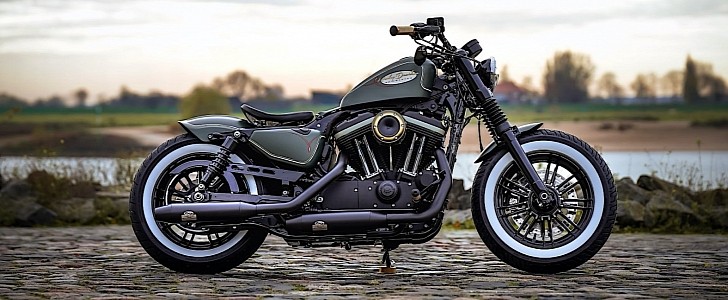Harley-Davidson’s Forty-Eight is one of the three offerings of the American bike builder in the family that also includes the Iron 883 and Iron 1200. It is described by its maker as one with “fat tire style with an iconic peanut tank and bulldog stance,” and it stock form is nothing like the custom one we have here.
The build is the work of German custom shop Thunderbike, one that for the past quarter of a century has been reinterpreting Milwaukee-born machines for (mostly) European customers. The one we have here, known in the Thunderbike books as the Hunter, is no exception.
The bike went through the usual complement of changes, both visual and mechanical. It doesn’t take intense scrutiny to notice the motorcycle is riding closer to the ground than it usually does, thanks to the progressive suspension with shorter shock absorbers.
Or that there’s a new exhaust system in place, one with short mufflers, and wearing the badge of a producer called Dr. Jekill & Mr. Hyde. This one is coupled with a power air cleaner to make the engine breath easier and better, but we’re not told what that means for the bike’s performance.
The list of custom items fitted on the Forty-Eight is of course longer (you can study it in full here) and also includes a new leather saddle, new 90 cm (35-inch) handlebar, short front and rear fenders, custom grips and pegs.
The build is wrapped overall in a dark green paint, but that is offset by the gold and red pinstripes, and the use of brass here on there. A very nice touch is the use of Dunlop whitewall tires, making the rubber looks thinner than what Harley usually supplies.
The parts used for this build, not including the exhaust system, cost over 4,000 euros, which is about $4,800 at today’s exchange rates.
The bike went through the usual complement of changes, both visual and mechanical. It doesn’t take intense scrutiny to notice the motorcycle is riding closer to the ground than it usually does, thanks to the progressive suspension with shorter shock absorbers.
Or that there’s a new exhaust system in place, one with short mufflers, and wearing the badge of a producer called Dr. Jekill & Mr. Hyde. This one is coupled with a power air cleaner to make the engine breath easier and better, but we’re not told what that means for the bike’s performance.
The list of custom items fitted on the Forty-Eight is of course longer (you can study it in full here) and also includes a new leather saddle, new 90 cm (35-inch) handlebar, short front and rear fenders, custom grips and pegs.
The build is wrapped overall in a dark green paint, but that is offset by the gold and red pinstripes, and the use of brass here on there. A very nice touch is the use of Dunlop whitewall tires, making the rubber looks thinner than what Harley usually supplies.
The parts used for this build, not including the exhaust system, cost over 4,000 euros, which is about $4,800 at today’s exchange rates.





























